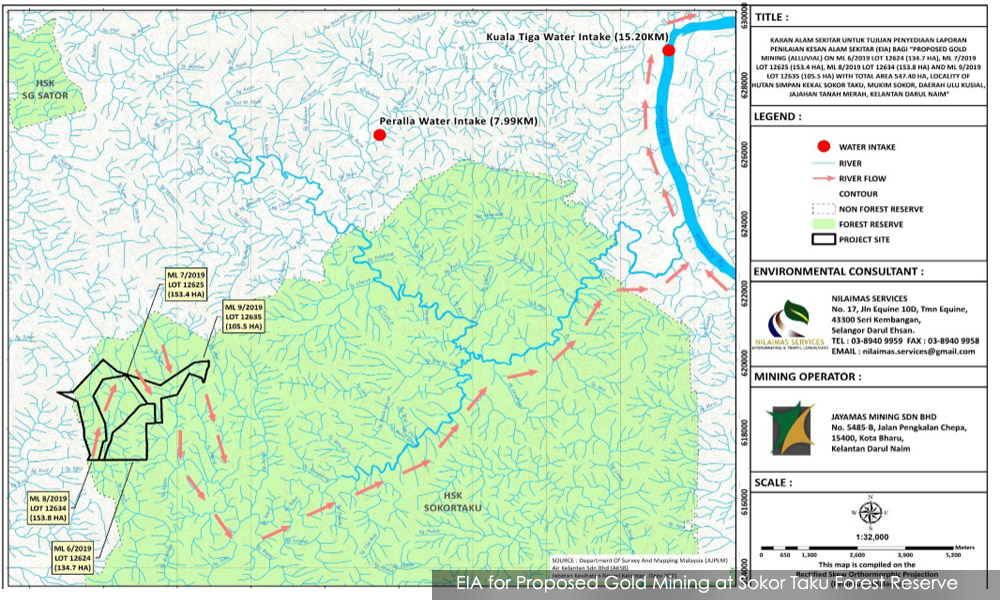A proposed open cast gold mine at the Sokor Taku Permanent Forest Reserve in Tanah Merah, Kelantan could pose a risk to both humans and critically endangered wildlife, an environmental impact assessment (EIA) report on the project showed.
This is because the project could lead to sedimentation and "catastrophic" flooding while encroaching on the habitat of animals such as the critically endangered Malayan tiger.
Besides the Malayan tiger, camera traps at the 547.4ha project site also captured images of the endangered Asian elephant and vulnerable Malayan sun bear.
The camera traps at the site, which is the equivalent size of 767 football fields, have caught images of tiger prey as well including kijang (a type of deer) and wild boar.
This comes as conservationists warn that the Malayan tiger could become extinct in a matter of decades, with only about 150 left in the wild, down from 1,000 in 2009.

In a meeting between the project’s environmental consultants, the National Wildlife Department (Perhilitan) also said the Sokor Taku Forest Reserve is home to three herds of elephants.
This is despite parts of the reserve already being logged, an officer said according to the meeting minutes published along with the EIA.
In 2021 alone, Perhilitan had captured seven elephants from the Sokor Taku herd, after they were believed to have come into conflict with humans, the minutes read.
There are an estimated 3,000 Asian elephants left in the wild in Malaysia.
In the meeting, Perhilitan advised that the mine be constructed in stages to allow animals living there to migrate naturally, and to avoid human-animal conflict.
Despite the large project footprint, excavation activities will only take place on 21.75ha, or 30 football fields, with the rest earmarked for future development.

No re-zoning required
Located within the Greater Taman Negara Complex, the proposed mining site is only 4.32km away from a Central Forest Spine linkage.
The Central Forest Spine is a biodiversity-rich ecological corridor used by endangered wildlife to move from one forest complex to another, from Johor to the Thai border.
The mine is estimated to have reserves of about 121.78kg in gold, with a total throughput of about 347,852 cubic metres.
The mining lease is held by state agency Yayasan Kraftangan Kelantan, while the operator listed is Jayamas Mining Sdn Bhd, a Kota Bharu-based mining and plantation firm.
The firm is owned by Kelantan dignitary Syed Abdullah Syed Ali Alsagoff and Wan Muhammad Imran Mohamad Kahiri, with a paid-up capital of RM5 million.
Wan Muhammad Imran, 28, owns 90 percent of the company and is based in Kajang, Selangor.
According to the 2020 Tanah Merah Local Plan (Rancangan Tempatan Jajahan Tanah Merah), the site is located in an area of the forest reserve classified as Class J, where mining is permitted with state permission.

Further, in December 2020, the Kelantan state executive council decreed that all permanent forest reserves be declassified as environmentally sensitive areas, except for water resource or water containment areas.
As such, there is no need for re-zoning to allow for mining at the proposed site.
Catastrophic flooding possible
The EIA, which went on display today, said the project could lead to "catastrophic" floods, as the exposed land would lead to sedimentation-filled runoff in downpours, making rivers shallow.
This is especially so as the project means the loss of secondary forests which now act as flood storage, the EIA read.
"River shallowing due to sedimentation can also become worse as the river hydraulic ability is reduced and fails to convey a high volume of water during a downpour, triggering (a) river overspill event and catastrophic flood," the report read.
The sedimentation would also "brutally compromise" the river ecosystem, obliterating local fish leaving greater populations of hardier introduced species like the catfish, it read.
This can only be averted if there is a zero-discharge policy during mining and other measures like a sediment trap installed during construction.
Even so, it said the existing total suspended solids already in the river means that the slightest hiccup in the mitigation measures taken would cause damage to the river.

The Sungai Sokor catchment will be directly impacted, with several of its tributaries located at the project site.
The tributaries drain into the main channel of Sungai Sokor and flow into Sungai Kelantan.
The project "might also impact" the Kuala Tiga water treatment plant intake, located 15.2km downstream from the mine, the EIA report read.
Despite acknowledging the irreversible impact on the environment, the EIA report recommends that the project is approved, with strict environmental management guidelines as mitigation.
It also highlights the economic benefit it could bring to the local community, who are mostly low-income earners.
Further, it said, the proposed mine would not be the first in the Sokor area.
The CNMC Group, which owns the biggest gold mine in Sokor, has produced more than three metric tonnes of gold.
The EIA report is on public display until May 17, while public feedback can be given through an online form by June 1. - Mkini




No comments:
Post a Comment
Note: Only a member of this blog may post a comment.